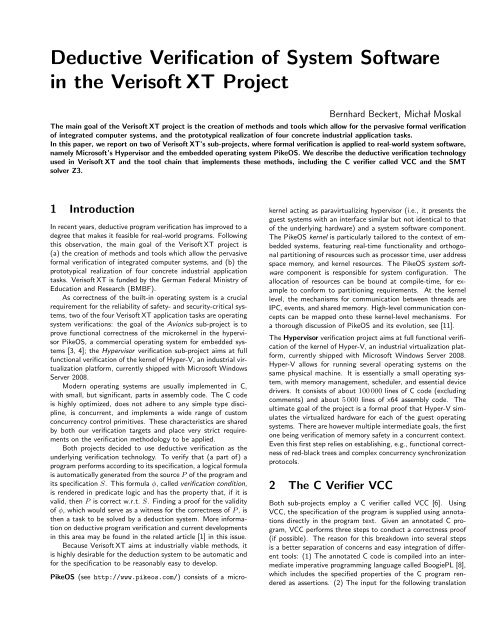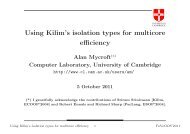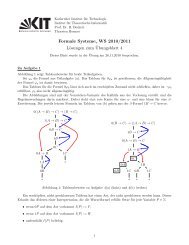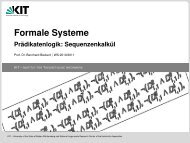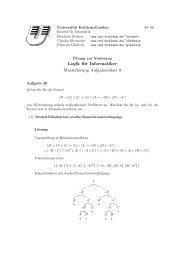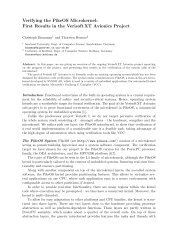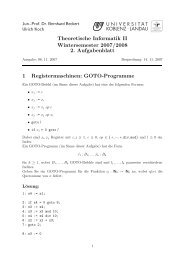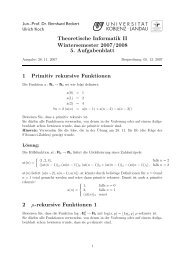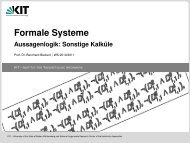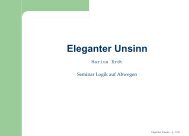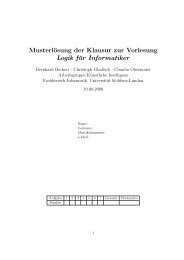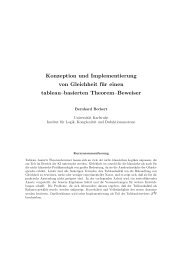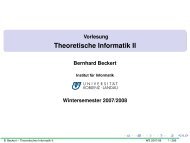Deductive Verification of System Software in the Verisoft XT Project
Deductive Verification of System Software in the Verisoft XT Project
Deductive Verification of System Software in the Verisoft XT Project
You also want an ePaper? Increase the reach of your titles
YUMPU automatically turns print PDFs into web optimized ePapers that Google loves.
<strong>Deductive</strong> <strong>Verification</strong> <strong>of</strong> <strong>System</strong> S<strong>of</strong>tware<br />
<strong>in</strong> <strong>the</strong> Veris<strong>of</strong>t <strong>XT</strong> <strong>Project</strong><br />
Bernhard Beckert, Micha̷l Moskal<br />
The ma<strong>in</strong> goal <strong>of</strong> <strong>the</strong> Veris<strong>of</strong>t <strong>XT</strong> project is <strong>the</strong> creation <strong>of</strong> methods and tools which allow for <strong>the</strong> pervasive formal verification<br />
<strong>of</strong> <strong>in</strong>tegrated computer systems, and <strong>the</strong> prototypical realization <strong>of</strong> four concrete <strong>in</strong>dustrial application tasks.<br />
In this paper, we report on two <strong>of</strong> Veris<strong>of</strong>t <strong>XT</strong>’s sub-projects, where formal verification is applied to real-world system s<strong>of</strong>tware,<br />
namely Micros<strong>of</strong>t’s Hypervisor and <strong>the</strong> embedded operat<strong>in</strong>g system PikeOS. We describe <strong>the</strong> deductive verification technology<br />
used <strong>in</strong> Veris<strong>of</strong>t <strong>XT</strong> and <strong>the</strong> tool cha<strong>in</strong> that implements <strong>the</strong>se methods, <strong>in</strong>clud<strong>in</strong>g <strong>the</strong> C verifier called VCC and <strong>the</strong> SMT<br />
solver Z3.<br />
1 Introduction<br />
In recent years, deductive program verification has improved to a<br />
degree that makes it feasible for real-world programs. Follow<strong>in</strong>g<br />
this observation, <strong>the</strong> ma<strong>in</strong> goal <strong>of</strong> <strong>the</strong> Veris<strong>of</strong>t <strong>XT</strong> project is<br />
(a) <strong>the</strong> creation <strong>of</strong> methods and tools which allow <strong>the</strong> pervasive<br />
formal verification <strong>of</strong> <strong>in</strong>tegrated computer systems, and (b) <strong>the</strong><br />
prototypical realization <strong>of</strong> four concrete <strong>in</strong>dustrial application<br />
tasks. Veris<strong>of</strong>t <strong>XT</strong> is funded by <strong>the</strong> German Federal M<strong>in</strong>istry <strong>of</strong><br />
Education and Research (BMBF).<br />
As correctness <strong>of</strong> <strong>the</strong> built-<strong>in</strong> operat<strong>in</strong>g system is a crucial<br />
requirement for <strong>the</strong> reliability <strong>of</strong> safety- and security-critical systems,<br />
two <strong>of</strong> <strong>the</strong> four Veris<strong>of</strong>t <strong>XT</strong> application tasks are operat<strong>in</strong>g<br />
system verifications: <strong>the</strong> goal <strong>of</strong> <strong>the</strong> Avionics sub-project is to<br />
prove functional correctness <strong>of</strong> <strong>the</strong> microkernel <strong>in</strong> <strong>the</strong> hypervisor<br />
PikeOS, a commercial operat<strong>in</strong>g system for embedded systems<br />
[3, 4]; <strong>the</strong> Hypervisor verification sub-project aims at full<br />
functional verification <strong>of</strong> <strong>the</strong> kernel <strong>of</strong> Hyper-V, an <strong>in</strong>dustrial virtualization<br />
platform, currently shipped with Micros<strong>of</strong>t W<strong>in</strong>dows<br />
Server 2008.<br />
Modern operat<strong>in</strong>g systems are usually implemented <strong>in</strong> C,<br />
with small, but significant, parts <strong>in</strong> assembly code. The C code<br />
is highly optimized, does not adhere to any simple type discipl<strong>in</strong>e,<br />
is concurrent, and implements a wide range <strong>of</strong> custom<br />
concurrency control primitives. These characteristics are shared<br />
by both our verification targets and place very strict requirements<br />
on <strong>the</strong> verification methodology to be applied.<br />
Both projects decided to use deductive verification as <strong>the</strong><br />
underly<strong>in</strong>g verification technology. To verify that (a part <strong>of</strong>) a<br />
program performs accord<strong>in</strong>g to its specification, a logical formula<br />
is automatically generated from <strong>the</strong> source P <strong>of</strong> <strong>the</strong> program and<br />
its specification S. This formula φ, called verification condition,<br />
is rendered <strong>in</strong> predicate logic and has <strong>the</strong> property that, if it is<br />
valid, <strong>the</strong>n P is correct w.r.t. S. F<strong>in</strong>d<strong>in</strong>g a pro<strong>of</strong> for <strong>the</strong> validity<br />
<strong>of</strong> φ, which would serve as a witness for <strong>the</strong> correctness <strong>of</strong> P , is<br />
<strong>the</strong>n a task to be solved by a deduction system. More <strong>in</strong>formation<br />
on deductive program verification and current developments<br />
<strong>in</strong> this area may be found <strong>in</strong> <strong>the</strong> related article [1] <strong>in</strong> this issue.<br />
Because Veris<strong>of</strong>t <strong>XT</strong> aims at <strong>in</strong>dustrially viable methods, it<br />
is highly desirable for <strong>the</strong> deduction system to be automatic and<br />
for <strong>the</strong> specification to be reasonably easy to develop.<br />
PikeOS (see http://www.pikeos.com/) consists <strong>of</strong> a micro-<br />
kernel act<strong>in</strong>g as paravirtualiz<strong>in</strong>g hypervisor (i.e., it presents <strong>the</strong><br />
guest systems with an <strong>in</strong>terface similar but not identical to that<br />
<strong>of</strong> <strong>the</strong> underly<strong>in</strong>g hardware) and a system s<strong>of</strong>tware component.<br />
The PikeOS kernel is particularly tailored to <strong>the</strong> context <strong>of</strong> embedded<br />
systems, featur<strong>in</strong>g real-time functionality and orthogonal<br />
partition<strong>in</strong>g <strong>of</strong> resources such as processor time, user address<br />
space memory, and kernel resources. The PikeOS system s<strong>of</strong>tware<br />
component is responsible for system configuration. The<br />
allocation <strong>of</strong> resources can be bound at compile-time, for example<br />
to conform to partition<strong>in</strong>g requirements. At <strong>the</strong> kernel<br />
level, <strong>the</strong> mechanisms for communication between threads are<br />
IPC, events, and shared memory. High-level communication concepts<br />
can be mapped onto <strong>the</strong>se kernel-level mechanisms. For<br />
a thorough discussion <strong>of</strong> PikeOS and its evolution, see [11].<br />
The Hypervisor verification project aims at full functional verification<br />
<strong>of</strong> <strong>the</strong> kernel <strong>of</strong> Hyper-V, an <strong>in</strong>dustrial virtualization platform,<br />
currently shipped with Micros<strong>of</strong>t W<strong>in</strong>dows Server 2008.<br />
Hyper-V allows for runn<strong>in</strong>g several operat<strong>in</strong>g systems on <strong>the</strong><br />
same physical mach<strong>in</strong>e. It is essentially a small operat<strong>in</strong>g system,<br />
with memory management, scheduler, and essential device<br />
drivers. It consists <strong>of</strong> about 100 000 l<strong>in</strong>es <strong>of</strong> C code (exclud<strong>in</strong>g<br />
comments) and about 5 000 l<strong>in</strong>es <strong>of</strong> x64 assembly code. The<br />
ultimate goal <strong>of</strong> <strong>the</strong> project is a formal pro<strong>of</strong> that Hyper-V simulates<br />
<strong>the</strong> virtualized hardware for each <strong>of</strong> <strong>the</strong> guest operat<strong>in</strong>g<br />
systems. There are however multiple <strong>in</strong>termediate goals, <strong>the</strong> first<br />
one be<strong>in</strong>g verification <strong>of</strong> memory safety <strong>in</strong> a concurrent context.<br />
Even this first step relies on establish<strong>in</strong>g, e.g., functional correctness<br />
<strong>of</strong> red-black trees and complex concurrency synchronization<br />
protocols.<br />
2 The C Verifier VCC<br />
Both sub-projects employ a C verifier called VCC [6]. Us<strong>in</strong>g<br />
VCC, <strong>the</strong> specification <strong>of</strong> <strong>the</strong> program is supplied us<strong>in</strong>g annotations<br />
directly <strong>in</strong> <strong>the</strong> program text. Given an annotated C program,<br />
VCC performs three steps to conduct a correctness pro<strong>of</strong><br />
(if possible). The reason for this breakdown <strong>in</strong>to several steps<br />
is a better separation <strong>of</strong> concerns and easy <strong>in</strong>tegration <strong>of</strong> different<br />
tools: (1) The annotated C code is compiled <strong>in</strong>to an <strong>in</strong>termediate<br />
imperative programm<strong>in</strong>g language called BoogiePL [8],<br />
which <strong>in</strong>cludes <strong>the</strong> specified properties <strong>of</strong> <strong>the</strong> C program rendered<br />
as assertions. (2) The <strong>in</strong>put for <strong>the</strong> follow<strong>in</strong>g translation
step consists <strong>of</strong> two parts: (a) <strong>the</strong> BoogiePL code that results<br />
from compil<strong>in</strong>g <strong>the</strong> orig<strong>in</strong>al C source (<strong>in</strong>clud<strong>in</strong>g annotations) and<br />
(b) axiomatic descriptions (<strong>in</strong> BoogiePL syntax) <strong>of</strong> certa<strong>in</strong> aspects<br />
<strong>of</strong> <strong>the</strong> C programm<strong>in</strong>g language, called <strong>the</strong> BoogiePL prelude.<br />
The annotated BoogiePL program toge<strong>the</strong>r with <strong>the</strong> prelude<br />
is <strong>the</strong>n transformed <strong>in</strong>to first-order predicate logic formulas<br />
(verification conditions), which state that <strong>the</strong> program satisfies<br />
<strong>the</strong> annotated specification. (3) These verification conditions<br />
are given to <strong>the</strong> automatic <strong>the</strong>orem prover (SMT solver) Z3 [7]<br />
to check whe<strong>the</strong>r <strong>the</strong>y are valid, which <strong>the</strong>n implies that <strong>the</strong><br />
orig<strong>in</strong>al C program is correct w.r.t. <strong>the</strong> annotated specification.<br />
The possible results Z3 may return are: (1) The formulas are<br />
valid (Z3 has found a pro<strong>of</strong>). (2) At least one <strong>of</strong> <strong>the</strong> formulas<br />
is not valid (Z3 has found a counter-example). (3) Z3 runs out<br />
<strong>of</strong> resources (time or space). In Case (1) above, <strong>the</strong> program<br />
verification was successful. In Cases (2) and (3), <strong>the</strong> verification<br />
eng<strong>in</strong>eer has to analyse <strong>the</strong> problem and correct <strong>the</strong> error. In<br />
Case (2), <strong>the</strong> counter-example, which can be thought <strong>of</strong> as an<br />
execution trace, can be visualized us<strong>in</strong>g a VCC-specific tool with<br />
debugger-like <strong>in</strong>terface. In Case (3), one may also f<strong>in</strong>d that <strong>the</strong><br />
program <strong>in</strong>deed satisfies <strong>the</strong> annotations. Then new annotations<br />
(stronger <strong>in</strong>variants, helpful lemmas, etc.) have to be added.<br />
This process is repeated until a pro<strong>of</strong> is found.<br />
Annotation Language. The annotation language <strong>of</strong> VCC is<br />
guarded by C preprocessor macros. When verify<strong>in</strong>g, a flag is<br />
set so that <strong>the</strong>se macros evaluate to keywords specific to VCC,<br />
which <strong>in</strong> turn generates <strong>the</strong> correspond<strong>in</strong>g BoogiePL code out <strong>of</strong><br />
<strong>the</strong>m. If a normal C compiler is used (without this flag), all annotations<br />
evaluate to <strong>the</strong> empty str<strong>in</strong>g, so that <strong>the</strong> annotations<br />
are transparent for <strong>the</strong> compilation process.<br />
The VCC annotation language consists <strong>of</strong> side-effect-free C<br />
expressions, extended with first-order quantification, lambda expressions,<br />
and a number <strong>of</strong> constructs used to attach specifications<br />
to exist<strong>in</strong>g C constructs, e.g., to attach function contracts<br />
to function declarations, loop <strong>in</strong>variants to loops and so forth.<br />
Additionally one can also place explicit assertions <strong>in</strong> <strong>the</strong> runn<strong>in</strong>g<br />
code, e.g., to help <strong>in</strong> debugg<strong>in</strong>g specifications.<br />
Modularity. <strong>Verification</strong> <strong>in</strong> VCC is modular, both with respect<br />
to threads and functions. Functions are equipped with contracts<br />
<strong>in</strong> form <strong>of</strong> pre- and post-conditions, giv<strong>in</strong>g all necessary conditions<br />
to call <strong>the</strong> function and <strong>the</strong> guarantees on <strong>the</strong> state, when<br />
<strong>the</strong> function returns. Callers are <strong>the</strong>n verified with respect to<br />
<strong>the</strong> contracts, not bodies, <strong>of</strong> <strong>the</strong> called functions. The program<br />
is verified as if it were executed by a s<strong>in</strong>gle thread but, to handle<br />
concurrency, predicates describ<strong>in</strong>g knowledge about <strong>the</strong> state<br />
are weakened at possible po<strong>in</strong>ts <strong>of</strong> <strong>in</strong>terleav<strong>in</strong>gs to simulate <strong>the</strong><br />
effects <strong>of</strong> o<strong>the</strong>r threads.<br />
Ghost Fields and Ghost Code. <strong>Verification</strong> <strong>of</strong> complex, functional<br />
properties <strong>of</strong> programs has been, up to date, mostly done<br />
us<strong>in</strong>g <strong>in</strong>teractive, higher-order provers. VCC restricts <strong>the</strong> specification<br />
language not to use any higher order or specialized logics,<br />
and <strong>in</strong>stead relies on purely first-order specification for two reasons.<br />
The first one is automation: development <strong>of</strong> automatic<br />
first-order systems has received much more attention than ei<strong>the</strong>r<br />
specialized logics or higher-order logics. The second reason is<br />
<strong>the</strong> belief that first-order logic is better understood by “ord<strong>in</strong>ary”<br />
programmers.<br />
This restriction comes at a price. For example, <strong>the</strong> graph<br />
reachability relation, a crucial concept <strong>in</strong> specification <strong>of</strong> recursive<br />
data structures, is not expressible <strong>in</strong> first-order logic. In<br />
places where such relations are needed we <strong>in</strong>troduce ghost fields<br />
<strong>in</strong> data structures to keep track <strong>of</strong> <strong>the</strong> set <strong>of</strong> reachable objects<br />
and use ghost code to update <strong>the</strong>se fields whenever <strong>the</strong> data<br />
structure is updated. Ghost code is <strong>in</strong>troduced only to facilitate<br />
verification and is syntactically restricted not to alter execution<br />
<strong>of</strong> <strong>the</strong> physical code. We thus verify <strong>the</strong> program with ghost<br />
code, but <strong>the</strong> set <strong>of</strong> reachable physical states is <strong>the</strong> same with<br />
and without ghost code. VCC supports manipulation <strong>of</strong> a number<br />
<strong>of</strong> ghost-only types, <strong>in</strong>clud<strong>in</strong>g maps (from po<strong>in</strong>ters and <strong>in</strong>tegers<br />
<strong>in</strong>to arbitrary types) as well as entire states <strong>of</strong> execution,<br />
which can be captured and used to evaluate expressions <strong>in</strong> <strong>the</strong>m.<br />
Additionally, new user-def<strong>in</strong>ed ghost data types can be specified<br />
at <strong>the</strong> level <strong>of</strong> C, us<strong>in</strong>g function symbols and axioms.<br />
Ghost code and ghost state allow for <strong>in</strong>troduction <strong>of</strong> abstraction<br />
layers: for example a red-black tree, from <strong>the</strong> user’s po<strong>in</strong>t <strong>of</strong><br />
view, is represented as a ma<strong>the</strong>matical map, greatly simplify<strong>in</strong>g<br />
reason<strong>in</strong>g. Additionally ghost state is used to capture protocols<br />
us<strong>in</strong>g flags, ownership transfer, and two-state <strong>in</strong>variants. A significant<br />
advantage <strong>of</strong> ghost code is that it is well understood by<br />
“ord<strong>in</strong>ary” programmers, be<strong>in</strong>g much like code <strong>in</strong>troduced for<br />
debugg<strong>in</strong>g and runtime assertion check<strong>in</strong>g.<br />
We have been able to specify and verify multiple recursive<br />
data structures, as found <strong>in</strong> <strong>the</strong> Hyper-V code, some complex<br />
synchronisation primitives (sp<strong>in</strong> locks, reader-writer locks, rundowns,<br />
custom algorithms for message pass<strong>in</strong>g) and specify a<br />
good deal <strong>of</strong> data structure <strong>in</strong>variants. We currently do not face<br />
expressiveness problems with <strong>the</strong> restriction to first-order logic.<br />
Object Invariants and Ownership. One way to capture global<br />
properties <strong>of</strong> a s<strong>of</strong>tware system is to def<strong>in</strong>e <strong>in</strong>variants for data<br />
structures (i.e., structs <strong>in</strong> <strong>the</strong> case <strong>of</strong> C) used <strong>in</strong> <strong>the</strong> program.<br />
With VCC, such <strong>in</strong>variants can be given by annotat<strong>in</strong>g a<br />
struct with (arbitrarily many) <strong>in</strong>variant clauses. To enable<br />
modular reason<strong>in</strong>g about properties <strong>of</strong> complex data structures<br />
(e.g., po<strong>in</strong>ter structures or nested structs), and to capture relations<br />
between data structures, <strong>the</strong> concept <strong>of</strong> ownership between<br />
structured data is used (VCC’s ownership model is an extension<br />
<strong>of</strong> <strong>the</strong> one used <strong>in</strong> <strong>the</strong> Spec# methodology [13]). Every struct<br />
has exactly one “owner” and can itself own arbitrarily many<br />
structures. At <strong>the</strong> top <strong>of</strong> <strong>the</strong> ownership hierarchy, structs can<br />
be owned by execut<strong>in</strong>g threads. The ownership relation is provided<br />
explicitly <strong>in</strong> annotations by <strong>the</strong> verification eng<strong>in</strong>eer, and<br />
it reflects his/her abstract knowledge about <strong>the</strong> data structure<br />
and how it is used.<br />
3 The Deduction <strong>System</strong> Z3<br />
While <strong>the</strong>re are ongo<strong>in</strong>g efforts to accommodate different <strong>the</strong>orem<br />
provers <strong>in</strong>to <strong>the</strong> VCC tool cha<strong>in</strong> (<strong>in</strong>clud<strong>in</strong>g <strong>in</strong>teractive ones,<br />
like Isabelle/HOL [5]), <strong>the</strong> Veris<strong>of</strong>t <strong>XT</strong> sub-projects Hypervisor<br />
and Avionics mostly use <strong>the</strong> SMT solver called Z3 as <strong>the</strong> underly<strong>in</strong>g<br />
deduction eng<strong>in</strong>e. SMT stands for Satisfiability Modulo<br />
Theories. SMT solvers decide satisfiability <strong>of</strong> first-order formulas<br />
<strong>in</strong> presence <strong>of</strong> background <strong>the</strong>ories like <strong>in</strong>teger or bit-vector<br />
arithmetic, arrays, etc. Conjunctions <strong>of</strong> literals from <strong>the</strong> <strong>the</strong>ories<br />
are tested for satisfiability by decision procedures.
While most SMT solvers handle only quantifier-free, decidable<br />
logics, Z3 is also capable <strong>of</strong> solv<strong>in</strong>g problems with quantified<br />
formulas. Universal quantification is handled ei<strong>the</strong>r with <strong>in</strong>complete<br />
<strong>in</strong>stantiation heuristics, complete model-based <strong>in</strong>stantiation<br />
or with superposition based calculi. VCC uses only <strong>the</strong> first<br />
method, due to performance reasons.<br />
We shall now go through a simple program, how its correctness<br />
is encoded as an SMT formula, and how <strong>the</strong> SMT solver<br />
checks its satisfiability.<br />
1 void compute_abs ( <strong>in</strong>t *x)<br />
2 { if (*x < 0)<br />
3 *x = -(*x);<br />
4 assert (*x >= 0); }<br />
For brevity we skip pro<strong>of</strong> obligations stemm<strong>in</strong>g from check<strong>in</strong>g<br />
validity <strong>of</strong> memory accesses, so by correctness <strong>of</strong> <strong>the</strong> program we<br />
mean that <strong>the</strong> explicit assertion never fails. VCC generates <strong>the</strong><br />
follow<strong>in</strong>g three formulas. The unsatisfiability <strong>of</strong> <strong>the</strong> conjunction<br />
<strong>of</strong> <strong>the</strong>m implies <strong>the</strong> correctness <strong>of</strong> <strong>the</strong> program.<br />
∀H, p, v. rd(wr(H, p, v), p) = v (1)<br />
(rd(H0, x) < 0 ∧ H1 = wr(H0, x, −rd(H0, x))) ∨<br />
(¬(rd(H0, x) < 0) ∧ H1 = H0)<br />
(2)<br />
¬(rd(H1, x) ≥ 0) (3)<br />
The first conjunct (1) is one <strong>of</strong> <strong>the</strong> axioms describ<strong>in</strong>g <strong>the</strong> behavior<br />
<strong>of</strong> <strong>the</strong> heap: if one writes v at heap location p, <strong>the</strong>n read<strong>in</strong>g<br />
from <strong>the</strong> updated heap at p will yield v. There are more axioms<br />
describ<strong>in</strong>g <strong>the</strong> heap, as well as a few hundred o<strong>the</strong>r axioms encod<strong>in</strong>g<br />
<strong>the</strong> rest <strong>of</strong> <strong>the</strong> VCC verification methodology, which are<br />
not needed for this example. The second conjunct (2) encodes<br />
<strong>the</strong> semantics <strong>of</strong> <strong>the</strong> if statement: ei<strong>the</strong>r <strong>the</strong> condition was true,<br />
and <strong>the</strong> new heap is constructed by updat<strong>in</strong>g <strong>the</strong> old heap at x,<br />
or <strong>the</strong> condition was not true, and <strong>the</strong> new heap equals <strong>the</strong> old<br />
heap. F<strong>in</strong>ally, conjunct (3) says that <strong>the</strong> assertion is violated.<br />
A model for <strong>the</strong> conjunction <strong>of</strong> <strong>the</strong> three formulas corresponds<br />
to a program execution where <strong>the</strong> assertion is violated. If such<br />
a model does not exists (i.e., <strong>the</strong> formula is unsatisfiable), <strong>the</strong>n<br />
<strong>the</strong> program is correct.<br />
Let us now exam<strong>in</strong>e how <strong>the</strong> SMT solver establishes unsatisfiability<br />
<strong>of</strong> <strong>the</strong> conjunction. Generally, at first it ignores function<br />
symbols and quantified subformulas, and looks for a propositionally<br />
satisfy<strong>in</strong>g truth assignment to <strong>the</strong> atoms (where by atoms<br />
we mean applications <strong>of</strong> predicates and quantified subformulas)<br />
<strong>of</strong> <strong>the</strong> formula. Assume <strong>the</strong> first assignment <strong>the</strong> solver considers<br />
is to make <strong>the</strong> quantified formula (1) and H1 = H0 true and to<br />
make rd(H0, x) < 0 and rd(H1, x) ≥ 0 false. The un<strong>in</strong>terpreted<br />
function decision procedure (DP) 1 <strong>in</strong>fers rd(H0, x) = rd(H1, x)<br />
based on H1 = H0. The l<strong>in</strong>ear arithmetic DP perspective on<br />
this is ¬(a < 0) and ¬(b ≥ 0) (where a and b are abstractions<br />
<strong>of</strong> rd(H0, x) and rd(H1, x) respectively, <strong>the</strong> arithmetic<br />
DP is not concerned about <strong>the</strong>ir <strong>in</strong>ternal structure), and now<br />
it receives <strong>the</strong> literal a = b, and says that <strong>the</strong> result<strong>in</strong>g set<br />
<strong>of</strong> literals is unsatisfiable. Such situations, where <strong>the</strong> current<br />
literal assignment is unsatisfiable, are called a conflict. Then,<br />
1 Everyth<strong>in</strong>g that is not pure equality and propositional connectives<br />
is treated as <strong>the</strong>ory <strong>in</strong> SMT. This <strong>in</strong>cludes <strong>the</strong> un<strong>in</strong>terpreted function<br />
<strong>the</strong>ory, which could be axiomatized with ∀x1, ..., xn, y1, ..., yn.x1 =<br />
y1 ∧ ... ∧ xn = yn ⇒ f(x1, ..., xn) = f(y1, ..., yn) for every function<br />
symbol f with arity n.<br />
<strong>the</strong> DPs narrow down <strong>the</strong> subset <strong>of</strong> currently assigned literals,<br />
that actually participate <strong>in</strong> <strong>the</strong> conflict. A disjunction <strong>of</strong> negations<br />
<strong>of</strong> those literals is called conflict clause and is a tautology<br />
modulo background <strong>the</strong>ories. In our case <strong>the</strong> conflict clause is:<br />
rd(H0, x) < 0 ∨ ¬(H1 = H0) ∨ rd(H1, x) ≥ 0. Because <strong>the</strong><br />
conflict clause is a tautology, conjo<strong>in</strong><strong>in</strong>g it to <strong>the</strong> <strong>in</strong>put formula<br />
does not change <strong>the</strong> satisfiability status <strong>of</strong> <strong>the</strong> <strong>in</strong>put formula.<br />
After we conjo<strong>in</strong> it, <strong>the</strong> search space narrows down: a class <strong>of</strong><br />
literal assignments, <strong>in</strong>clud<strong>in</strong>g <strong>the</strong> current one, is propositionally<br />
excluded. In our case, <strong>the</strong> only rema<strong>in</strong><strong>in</strong>g possible propositional<br />
assignment for our formula is to make <strong>the</strong> quantified formula (1),<br />
rd(H0, x) < 0, and H1 = wr(H0, x, −rd(H0, x)) true, and to<br />
make rd(H1, x) ≥ 0 false. These literals do not conflict at <strong>the</strong><br />
ground level, and thus <strong>the</strong> quantified formula is <strong>in</strong>stantiated.<br />
The follow<strong>in</strong>g tautology is conjo<strong>in</strong>ed to <strong>the</strong> orig<strong>in</strong>al formula:<br />
(∀H, p, v. rd(wr(H, p, v), p) = v) ⇒<br />
rd(wr(H0, x, −rd(H0, x)), x) = −rd(H0, x)<br />
The propositional assignment is <strong>the</strong>n extended to make <strong>the</strong> literal<br />
rd(wr(H0, x, −rd(H0, x)), x) = −rd(H0, x) true, which is<br />
<strong>the</strong> only way to satisfy <strong>the</strong> implication above. The un<strong>in</strong>terpreted<br />
function DP <strong>in</strong>fers ¬(−rd(H0, x) ≥ 0), and <strong>the</strong> l<strong>in</strong>ear arithmetic<br />
view <strong>of</strong> a < 0 and ¬(−a ≥ 0) generates a conflict clause, which<br />
blocks <strong>the</strong> only rema<strong>in</strong><strong>in</strong>g propositional assignment. The formula<br />
is thus deemed unsatisfiable.<br />
This description <strong>of</strong> <strong>the</strong> pro<strong>of</strong> search highlights <strong>the</strong> most important<br />
features <strong>of</strong> SMT solvers. (1) Handl<strong>in</strong>g <strong>of</strong> <strong>the</strong> propositional<br />
structure <strong>of</strong> <strong>the</strong> formula is very much like <strong>in</strong> <strong>the</strong> modern,<br />
extremely efficient, propositional SAT solvers. (2) Multiple DPs<br />
build <strong>in</strong>to <strong>the</strong> SMT solvers need to cooperate, <strong>in</strong> our example<br />
<strong>the</strong> un<strong>in</strong>terpreted function DP propagated equality to <strong>the</strong> l<strong>in</strong>ear<br />
arithmetic DP. (3) The search space is narrowed by <strong>the</strong> conflict<br />
clauses that <strong>the</strong> SMT solver learns dur<strong>in</strong>g <strong>the</strong> search. (4) The<br />
quantified formulas are handled by <strong>in</strong>stantiation and, <strong>the</strong>refore,<br />
we need some heuristic to decide how to <strong>in</strong>stantiate.<br />
The heuristic which we use <strong>in</strong> Z3 for VCC is based on Ematch<strong>in</strong>g.<br />
2 Certa<strong>in</strong> subterms <strong>of</strong> <strong>the</strong> quantified formula body are<br />
designated as triggers. The SMT solver searches for substitutions,<br />
which make <strong>the</strong> triggers equal to some subterms <strong>of</strong> currently<br />
assigned ground literals, <strong>in</strong> hope that an <strong>in</strong>stance shar<strong>in</strong>g<br />
subterms with <strong>the</strong> current ground problem will be relevant for<br />
<strong>the</strong> search. For example, let us assume <strong>the</strong> trigger for <strong>the</strong> heap<br />
axiom is rd(wr(H, p, v), p). At <strong>the</strong> moment, where we needed<br />
<strong>the</strong> <strong>in</strong>stantiation, <strong>the</strong> ground literals <strong>in</strong>cluded ¬(rd(H1, x) ≥ 0)<br />
and H1 = wr(H0, x, −rd(H0, x))). If we take<br />
<strong>the</strong>n<br />
σ = [H := H0, p := x, v := −rd(H0, x)] ,<br />
σ(rd(wr(H, p, v), p)) = rd(H1, x) ,<br />
because H1 = wr(H0, x, −rd(H0, x))) (we thus consider <strong>the</strong><br />
currently assumed equality atoms).<br />
The triggers can be ei<strong>the</strong>r explicitly supplied to <strong>the</strong> SMT<br />
solver, or <strong>the</strong> solver can select <strong>the</strong>m us<strong>in</strong>g a simple heuristic.<br />
The explicit trigger<strong>in</strong>g has proven to be a powerful, if somewhat<br />
arcane, tool for build<strong>in</strong>g custom SMT <strong>the</strong>ories, like <strong>the</strong> one describ<strong>in</strong>g<br />
a particular verification methodology [9, 10, 2, 12]. The<br />
2 The E <strong>in</strong> “E-match<strong>in</strong>g”stands for equality.
trigger<strong>in</strong>g annotation can be viewed as a logic programm<strong>in</strong>g language<br />
used to implement a <strong>the</strong>ory to be executed by <strong>the</strong> SMT<br />
solver. Of course one could also implement <strong>the</strong> <strong>the</strong>ory <strong>in</strong>side an<br />
SMT solver, which would likely be much more efficient, but <strong>the</strong><br />
implementation would be much harder. Given how fast such a<br />
<strong>the</strong>ory evolves dur<strong>in</strong>g development <strong>of</strong> a verification tool, it seems<br />
counterproductive <strong>in</strong> most cases.<br />
The problems stemm<strong>in</strong>g from deductive s<strong>of</strong>tware verification<br />
are quite different from <strong>the</strong> ground SMT problems that mostly<br />
result from hardware verification. For example, <strong>the</strong> number <strong>of</strong><br />
conflicts per time unit that <strong>the</strong> solver f<strong>in</strong>ds tends to a thousand<br />
times smaller for s<strong>of</strong>tware. This is not enough to calibrate<br />
usual heuristics for order<strong>in</strong>g propositional assignments. Also <strong>the</strong><br />
implementation <strong>of</strong> various <strong>in</strong>dices for E-match<strong>in</strong>g is crucial for<br />
performance. Z3 is very good with ground SMT problems, and<br />
it is def<strong>in</strong>itely <strong>the</strong> lead<strong>in</strong>g solver for quantified queries. This is<br />
partially a result <strong>of</strong> close collaboration between <strong>the</strong> authors <strong>of</strong><br />
Z3 and researchers us<strong>in</strong>g it for s<strong>of</strong>tware verification.<br />
4 Conclusion<br />
The Hypervisor sub-project <strong>in</strong>volves up to 20 people work<strong>in</strong>g,<br />
mostly on specification <strong>of</strong> <strong>the</strong> Hyper-V, for three years, mak<strong>in</strong>g<br />
it one <strong>of</strong> <strong>the</strong> largest formal verification efforts ever attempted.<br />
While <strong>the</strong> Avionics sub-project is smaller, it still <strong>in</strong>volves <strong>the</strong> full<br />
functional verification <strong>of</strong> thousands <strong>of</strong> l<strong>in</strong>es <strong>of</strong> complex C code.<br />
Based on experience and results from <strong>the</strong> first half <strong>of</strong> <strong>the</strong><br />
project, we can conclude that verify<strong>in</strong>g concurrent system s<strong>of</strong>tware<br />
written <strong>in</strong> C and assembly code is difficult and at <strong>the</strong> edge<br />
<strong>of</strong> <strong>the</strong> state <strong>of</strong> <strong>the</strong> art <strong>of</strong> s<strong>of</strong>tware verification. But given sufficient<br />
resources, it can be done and, consider<strong>in</strong>g <strong>the</strong> importance<br />
<strong>of</strong> correct system s<strong>of</strong>tware, is useful and feasible on an <strong>in</strong>dustrial<br />
scale. The Veris<strong>of</strong>t <strong>XT</strong> project emphasises <strong>the</strong> well-known<br />
fact that s<strong>of</strong>tware verification is one <strong>of</strong> <strong>the</strong> most important applications<br />
<strong>of</strong> automated deduction. The project’s success relies<br />
heavily on recent advances <strong>in</strong> deduction technology.<br />
References<br />
[1] Wolfgang Ahrendt, Bernhard Beckert, Mart<strong>in</strong> Giese, and Philipp<br />
Rümmer. Practical aspects <strong>of</strong> automated deduction for program<br />
verification. KI, 2009. In this issue.<br />
[2] Mike Barnett, K. Rustan M. Le<strong>in</strong>o, and Wolfram Schulte. The<br />
Spec# programm<strong>in</strong>g system: An overview. In Proc. CASSIS<br />
2004, LNCS 3362, pages 49–69. Spr<strong>in</strong>ger, 2005.<br />
[3] Christoph Baumann, Bernhard Beckert, Holger Blasum, and<br />
Thorsten Bormer. Better avionics s<strong>of</strong>tware reliability by code<br />
verification. In Proc. Embedded World Conference, 2009.<br />
[4] Christoph Baumann, Bernhard Beckert, Holger Blasum, and<br />
Thorsten Bormer. Formal verification <strong>of</strong> a microkernel used <strong>in</strong><br />
dependable s<strong>of</strong>tware systems. In Proc. SAFECOMP 2009, LNCS.<br />
Spr<strong>in</strong>ger, 2009. To appear.<br />
[5] Sascha Böhme, Micha̷l Moskal, Wolfram Schulte, and Burkhart<br />
Wolff. HOL-Boogie: An <strong>in</strong>teractive prover-backend for <strong>the</strong> Verifiy<strong>in</strong>g<br />
C Compiler. Journal <strong>of</strong> Automated Reason<strong>in</strong>g, 2009. To<br />
appear.<br />
[6] Ernie Cohen, Markus Dahlweid, Mark Hillebrand, Dirk Le<strong>in</strong>enbach,<br />
Micha̷l Moskal, Thomas Santen, Wolfram Schulte, and<br />
Stephan Tobies. VCC: A practical system for verify<strong>in</strong>g concurrent<br />
C. In Proc. TPHOLs 2009, LNCS 5674, pages 23–42. Spr<strong>in</strong>ger,<br />
2009. Invited paper.<br />
[7] Leonardo de Moura and Nikolaj Bjørner. Z3: An efficient SMT<br />
solver. In Proc. TACAS 2008, LNCS 4963, pages 337–340.<br />
Spr<strong>in</strong>ger, 2008.<br />
[8] Rob DeL<strong>in</strong>e and K. Rustan M. Le<strong>in</strong>o. BoogiePL: A typed procedural<br />
language for check<strong>in</strong>g object-oriented programs. Technical<br />
Report MSR-TR-2005-70, Micros<strong>of</strong>t Research, 2005.<br />
[9] David L. Detlefs, K. Rustan M. Le<strong>in</strong>o, Greg Nelson, and James B.<br />
Saxe. Extended static check<strong>in</strong>g. SRC Research Report 159,<br />
Compaq <strong>System</strong>s Research Center, Palo Alto, 1998.<br />
[10] Cormac Flanagan, K. Rustan M. Le<strong>in</strong>o, Mark Lillibridge, Greg<br />
Nelson, James B. Saxe, and Raymie Stata. Extended static<br />
check<strong>in</strong>g for Java. In Proc. PLDI 2002, SIGPLAN Notices 37,<br />
pages 234–245. ACM, 2002.<br />
[11] Robert Kaiser and Stephan Wagner. Evolution <strong>of</strong> <strong>the</strong> PikeOS<br />
microkernel. In Proc. 1st International Workshop on Microkernels<br />
for Embedded <strong>System</strong>s (MIKES), 2007. Available<br />
at http://ertos.nicta.com.au/publications/papers/<br />
Kuz_Petters_07.pdf.<br />
[12] Shuvendu K. Lahiri and Shaz Qadeer. Back to <strong>the</strong> future: revisit<strong>in</strong>g<br />
precise program verification us<strong>in</strong>g SMT solvers. In Proc.<br />
POPL 2008, pages 171–182. ACM, 2008.<br />
[13] K. Rustan M. Le<strong>in</strong>o and Peter Müller. Object <strong>in</strong>variants <strong>in</strong> dynamic<br />
contexts. In Proc. ECOOP 2008, LNCS 3086. Spr<strong>in</strong>ger,<br />
2004.<br />
Contact<br />
Pr<strong>of</strong>. Dr. Bernhard Beckert<br />
Karlsruhe Institute <strong>of</strong> Technology<br />
Institute for Theoretical Informatics<br />
Am Fasanengarten 5, 76131 Karlsruhe, Germany<br />
Phone: +49 721 608-4025<br />
Email: beckert@kit.de<br />
Micha̷l Moskal<br />
European Micros<strong>of</strong>t Innovation Center<br />
Ritterstrasse 23, 52072 Aachen, Germany<br />
Email: michal.moskal@micros<strong>of</strong>t.com<br />
Bild Bernhard Beckert is a pr<strong>of</strong>essor <strong>of</strong><br />
Application-oriented Formal <strong>Verification</strong><br />
at <strong>the</strong> Karlsruhe Insitute <strong>of</strong> Technology.<br />
His research <strong>in</strong>terests <strong>in</strong>clude automated<br />
deduction, non-classical logics, and formal<br />
methods <strong>in</strong> s<strong>of</strong>tware eng<strong>in</strong>eer<strong>in</strong>g.<br />
Bild Micha̷l Moskal is a researcher at <strong>the</strong> European<br />
Micros<strong>of</strong>t Innovation Center, Aachen,<br />
Germany, closely collaborat<strong>in</strong>g with <strong>the</strong> Research<br />
<strong>in</strong> S<strong>of</strong>tware Eng<strong>in</strong>eer<strong>in</strong>g Group at Micros<strong>of</strong>t<br />
Research, Redmond, USA. He is also<br />
a PhD student at <strong>the</strong> Computer Science Institute<br />
<strong>of</strong> <strong>the</strong> University <strong>of</strong> Wroc̷law, Poland.<br />
His research currently focuses on s<strong>of</strong>tware<br />
verification with SMT and <strong>the</strong> VCC verifier<br />
<strong>in</strong> particular.


